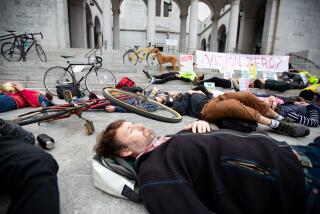Death Toll on Vietnam’s Roads Soars
- Share via
HANOI — The grim statistics are in: 1997 was the bloodiest year on Vietnam’s roads, with accidents claiming 6,000 lives, a 22% jump over the previous year.
That may not seem alarming compared with the United States, where more than 40,000 people a year die in traffic accidents. But the United States has more than 200 million registered vehicles and about 4 million miles of roads; Vietnam has 417,000 vehicles and 39,000 miles of roads.
Police officials here declined to discuss what they admit is a “serious national problem,” but international safety experts rate Vietnam’s roads as among the world’s deadliest. Hanoi’s top surgical hospital alone treats about 70 traffic-accident victims a day.
In one three-day period last month, the road carnage included: 50 dead when two buses crashed head-on in Binh Dinh province; 14 dead in the collision of a bus and cement truck outside Ho Chi Minh City; and 40 dead when a bus plunged off a bridge near the city of Qui Nhon.
The reasons for a body count reminiscent of the war years are many. With only one north-south highway, roads are crowded--shared by pedestrians, bicyclists, animals and 5 million motor scooters--and in poor condition. Traffic enforcement is all but nonexistent. Many drivers have simply never learned how to drive, though everyone is required to navigate a circle-8 course and answer a 10-question, multiple-choice quiz before being licensed at 16 years old or older.
Careless driving causes 80% of all traffic fatalities, the government reports. Excessive speed is to blame for 55%, while 8% are attributed to drunken driving--a much lower figure than in the United States, where alcohol historically contributes to about half of all traffic deaths.
Help may be on the way. The World Bank plans to begin a traffic-management program in Hanoi and Ho Chi Minh City this summer in hopes of bringing some order to chaotic roads, and the Vietnamese government says it is going to get tough on errant drivers. In October, it began checking vehicles to ensure that they meet safety and pollution standards, issuing stickers to those that pass.
Ford Vietnam, the only U.S. car manufacturer in the country, has taken another tack to ensure that drivers survive once they leave the showroom.
The company is offering free, daylong driving courses in Hanoi, Da Nang and Ho Chi Minh City to drivers and owners of Ford products.
Still, for the initiated, navigating Vietnam’s roads can be an unnerving proposition.
A decade ago, Hanoi’s streets were used by bicycles and a few Russian-made trucks. Now they are clogged with tens of thousands of motor scooters, all speeding in free-form anarchy, horns honking, weaving around cars and trucks, passing bicyclists and pedestrians, who walk on the streets because the sidewalks are used to park bikes and scooters.
No one yields, and there are no established rights of way. Driving down the left lane of a two-way street is acceptable if the driver eventually intends to turn left. Driving the wrong way down a one-way street is OK if it is the shortest distance between two points. U-turns from the curbside lane are common. Stopping in the middle of a jammed roadway to chat or stare into a shop window is not considered bad driving.
Occasionally, police officers will appear and wave over drivers. But the underpaid officers usually are not concerned about traffic safety. They are looking for lunch money, and deals are quickly negotiated. The practice continues despite government warnings that it is unacceptable.
“I liked Hanoi better when it was quieter, safer,” said a 60-year-old parking lot attendant who rides his bike to work.
He can take little solace in what the future holds as Vietnam’s more liberalized economic policies bring increased prosperity. Car sales last year were up 12% over the year before; motor scooter sales, 20%.
What is odd about driving habits in Vietnam is that in most ways, this is a polite, disciplined society. Motor scooter drivers and bicyclists will cut each other off, swerving at the last second to avoid a wreck, and never consider cussing or making an obscene gesture. Only when the most grievous examples of wacky driving cause a serious spill do they come to blows.
But in a society where freedom of expression and action are limited, the roads have become Vietnam’s outlet. They are where people can rebel against conformity and government restrictions and, even though they put their lives at risk, play the role of anarchist for a few brief, high-speed moments each day.
More to Read
Sign up for Essential California
The most important California stories and recommendations in your inbox every morning.
You may occasionally receive promotional content from the Los Angeles Times.













